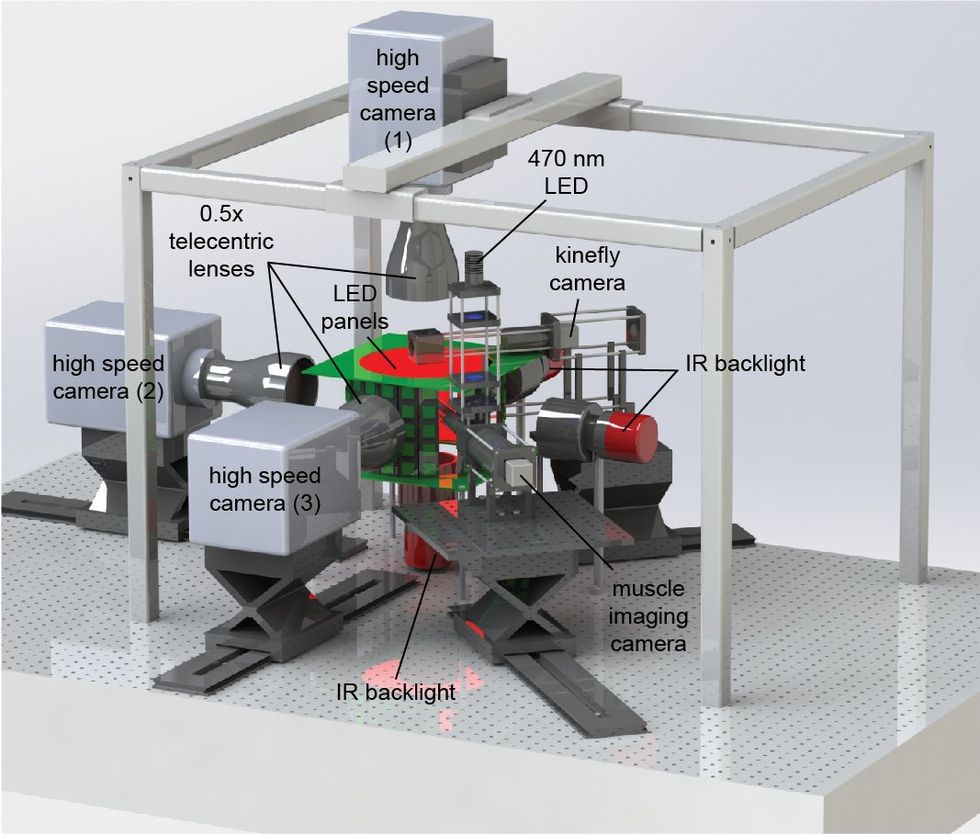Hundreds of millions of years ago, insect wings evolved as a novel structure, attached to the body with a complex hinge structure. That structure transforms minute muscle movements into flight, and it remains an evolutionary mystery to biologists.
“This wing hinge is arguably one of the most important events that ever happened in the evolution of life,” says Michael Dickinson, a researcher and professor of bioengineering and aeronautics at Caltech who studies insect flight. “It’s one of the most amazing structures.”
To better understand the role each individual muscle plays in controlling the wing hinge, Dickinson and his colleagues devised an experiment to simultaneously record a fruit fly’s muscle movement and the resulting wing motion. Like the wing hinge itself, the experimental setup is complex. The researchers recorded high-precision data on all 12 of the fly’s minuscule wing muscles, as well as wing-movement patterns in three dimensions, all while keeping the insect “happy” and in motion. “To do all that simultaneously required an enormous amount of engineering,” Dickinson says.

The fly was surrounded by a panoramic array of LED displays to simulate environmental cues. These cues effectively create a “video game” for the fly, Dickinson says, causing the insect to change its flight pattern. The panoramic display could change to prompt an insect to fly to the left, right, up, or down, as well as speed up or slow down.
Dickinson says that LED panels are often used with fly experiments because the insects have the fastest visual systems on the planet and can distinguish individual flickers of light up to about 200 times each second. By comparison, most video is shot at 24 frames per second. “A fly would see that as a slideshow,” Dickinson says.
In order to record muscle movements, the flies were genetically engineered so the appropriate muscles would glow when active. A microscope was designed to project light of a particular wavelength onto the fly to excite the fluorescent muscles, then record the excited light.
Meanwhile, the wing motion was captured with three high-speed cameras, set to record the data at 15,000 frames per second. The cameras had to operate at high spatial resolution as well, in order to capture the tiny differences in muscle movements that can result in significant changes to the insect’s flight. Because of the extremely short exposure time, the cameras require a lot of light to produce images, Dickinson says. The researchers used infrared light cameras to avoid blinding the insects while capturing images.
Lastly, the setup included a third camera that provided real-time feedback about the size of each wing beat, in order to guide the LED simulation’s response to how the fly flew.
Insect Flight Control Mechanics Revealedwww.youtube.com
The experiment gathered terabytes of data encapsulating 72,000 wingbeats, which were divided into a training and a testing dataset. The training data was then used to develop a neural network that predicts wing motion based on muscle activity. “To get the richness of what this system of muscles can do, we needed a lot of data” across a wide array of flight patterns, Dickinson says.
Working with the animals presented additional challenges in developing the experiment. For example, because the lights and electronic instruments generate heat, the researchers had to ensure the room was cool enough. “Flies are very finicky about temperature,” Dickinson says. The fruit flies used in the experiment are reluctant to fly in conditions above 25 °C.
Currently, the experiment works only with these laboratory fruit flies, which are the sole species that can be genetically modified to image muscles simultaneously. However, the researchers hope to compare their results with other experiments using mosquitos in the future. They’re also keen to build a computer simulation as a stepping stone toward designing physical structures using the principles of the insects’ wings.
“All the cool engineering aside,” Dickinson says, “flight is just amazing.”
- Startup IOTree: A Spritz in Time Saves Crops From Flies ›
- Scientists Control a Fly’s Heart With a Laser ›
Gwendolyn Rak is a contributor to IEEE Spectrum with interests in biotechnology and aerospace. She holds a master’s degree in science journalism from New York University.


